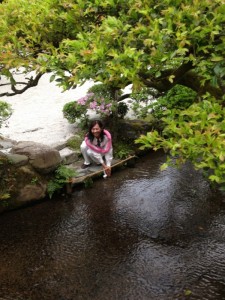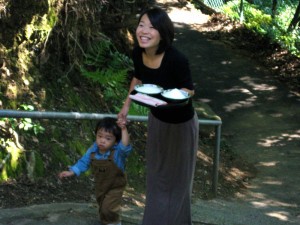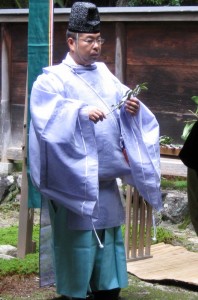This is part of an ongoing series about the Shinto manner of handling funerals and death. Though Buddhist funerals remain the norm, special Shinto funerals do take place and their ritual procedure is a little different. In this adapted piece from Elizabeth Kenney’s article, the focus is on the wake, when people gather to commemorate the deceased. (For Part 1 of the series, click here.)
***********************
Wake
The Shinto wake, like the Buddhist wake, is usually held the day before the funeral ceremony. In some cases, the wake is a gathering of relatives and friends without a special program of activities. In other cases, the wake is structured very similarly to the funeral. And in yet others (increasingly the norm, it seems) the guests attend the wake very briefly, almost in an assembly-line fashion. The priests, of course, perform their ritual duties as before, but their only audience is the close family of the deceased.

Ritual ablution has always been important for Shinto, dating back to hand washing in streams
The mourners at a Shinto wake must purify their hands and mouths with water before entering the room. Usually, the funeral company will have set up a small bucket of water and a ladle for the guests. White paper or small towels may also be provided.
If the wake is held in a private home, the purification may be performed at the bathroom sink, if no other arrangement is possible. In that case, the guest should simply wash his hands and not rinse out his mouth (because it would be too rude to spit in someone else’s sink — an everyday etiquette taboo being more compelling than the need to observe the established Shinto methods of purifying oneself, which definitely include rinsing out one’s mouth).
People perform the same simple purification again before attending the funeral. This hand-washing rite is one of the rituals that distinguishes a Shinto wake or funeral from a Buddhist one. It is not that purification is absent from a Buddhist funeral: participants in a Buddhist funeral purify themselves only after the funeral (with salt) before reentering their home or workplace. A guest at a Shinto funeral does this, too.
The mourners’ self-purification before entering the wake or funeral place is analogous to the simple purification called for before one enters a Shinto shrine. A funeral is too polluted and polluting to be conducted at a shrine. Nonetheless, the presence of the Shinto priests and their ritual implements, perhaps especially the purification wand, transforms the secular house (or other building) into a sacred place that demands purification before entering.
Upon leaving a wake or funeral, the guest receives a small packet of salt, printed with the word “purification”. Even if one does not attend the wake or funeral, someone who has given condolence money (say, to an office colleague whose father has died) will still receive the packet of purification salt, in this case at the time of receiving the return-gift for the condolence money, usually forty-nine days after the death.

Salt plays an important part in Shinto rituals as a purifying agent
The return-gift might be small white towels (themselves symbolic of — and actually useful for! — purification) or a department store gift coupon. The interesting point here is that the office colleague who did not attend the funeral may seem not to have incurred the impurity of death, but he is still in need of purification. Other office colleagues, who did not give condolence money, receive no purification salt.
This can be understood either as long-distance attendance at the funeral (on the model of the Shinto “worship from afar”) or long-distance “contamination” with death pollution, since a route of “infection” can be traced through a series of contagious hands (like the 0-157 bacteria): he touched the condolence-money envelope, gave it to his bereaved colleague, and that envelope entered the realm of death pollution.
It is not always salt that is distributed for purification to people who have attended a Buddhist wake or funeral. At two wakes I attended recently, the mourners were handed a damp towel after paying their respects to the deceased.
The wake might include the following stages:
1 . The coffin-altar has been prepared by arranging the offerings of washed rice, salt, water, sake, vegetables, seaweed, cakes, etc. Also set up is a photo of the deceased — an important element of modern funerals. Other decorations are arranged as described above.
2. The priests and mourners enter the room.
3. The chief priest bows once, then the mourners bow once all together.
4. Food offerings are made.
5. The priest offers prayers and an elegy. A purification ceremony may also be performed at this point.
6. Offering of tamagushi: first the priests, then the chief mourner, followed by relatives in order of closeness and status, and finally friends and other mourners.
7. The offerings are taken away.
8. The chief priest bows, and the mourners then bow in unison.
9. The priests leave the room, while the mourners watch silently.

A priest about to present a tamagushi offering to a participant in a ceremony
When the mourners are called upon to present tamagushi at the altar of the deceased, they are on stage. This is the only real action they must perform, and, to judge by the attention devoted to the correct way of offering tamagushi in the etiquette books, it is something to worry about. The tamagushi offering takes only a few seconds, but to the novice it seems hopelessly complicated. Remember that most mourners, unlike the priests, have never done this before and have no chance to practice.
*************
How to offer tamagushi:
a. Receive the tamagushi from the priest.
b. Hold the tamagushi by placing your right hand, palm down, over the stem and grasping the branch with your thumb. Hold the leafy part in your left hand, with your palm facing up so that the leaves are on top of your palm. Bow in front of the altar.
c. Keeping the tamagushi pointing upward, rotate it clockwise until the stem, still held in your right hand, is pointing toward you.
d. Switch hands, so that the left hand is holding the stem and the right hand is holding the leaves. The palm of the right hand should be facing up.
e. Continue turning the tamagushi clockwise, with your left hand still holding the stem, until the stem is pointing away from you.
f. Place the tamagushi on the table, with the stem pointing toward the altar.
g. Bow twice. Clap twice without making noise (see below).
h. Bow once more. Return to your seat.
The tamagushi offering occurs in various Shinto rites: weddings, building dedications, memorial service for used needles, and so forth. The tamagushi itself symbolizes sacredness and purity. In the ritual context, it serves as a medium of exchange among the kami, priests, and lay people.
At a funeral, the tamagushi travels from the kami (symbolically) to the priest to the mourner to the deceased. This is not a descent, but a loop. In the funeral setting, the tamagushi has the added function of representing Shinto against Buddhism and Christianity. All three types of funerals include offerings from the mourners to the deceased, but each is purposefully differentiated from the others. Buddhists offer incense, while Christians offer flowers, and Shintôists offer tamagushi.

Tamagushi often play an important part in Shinto rituals, and knowing how to present them is an important part of the protocol

Leave a Reply